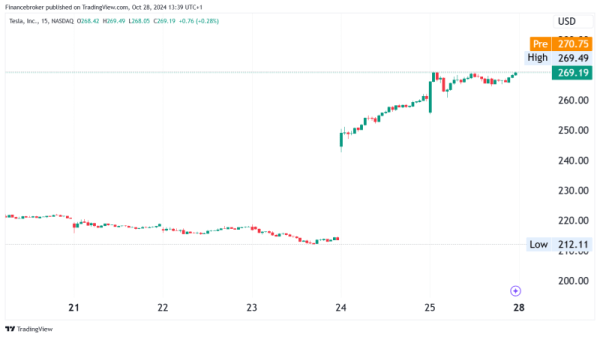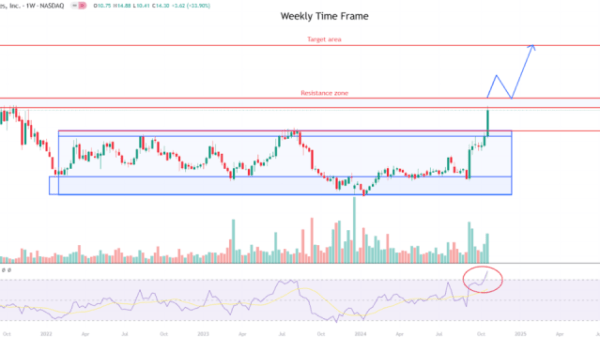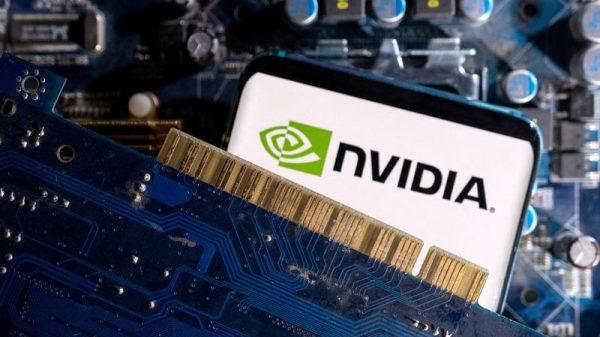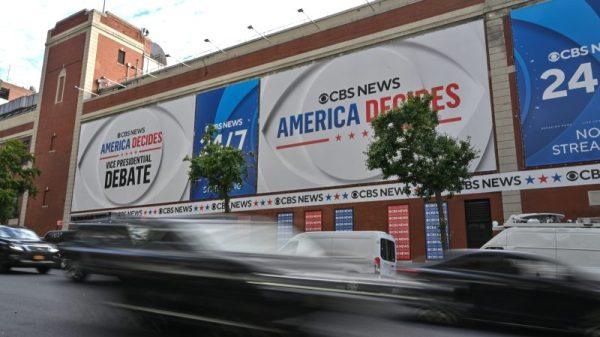JPMorgan Chase (NYSE: NYSE:JPM) reported a net income of $12.9 billion for the third quarter of 2024, with earnings per share (EPS) of $4.37 and total revenue of $43.3 billion, marking a 6% year-on-year increase.
Key Takeaways:
• Net income: $12.9 billion
• EPS: $4.37
• Total revenue: $43.3 billion (6% year-on-year increase)
• Consumer and Community Banking (CCB) ranked first in retail deposit share for the fourth consecutive year
• Asset and Wealth Management (AWM) saw record quarterly revenues and long-term inflows of $72 billion
• Common Equity Tier 1 (CET1) ratio remained stable at 15.3%
Company Outlook
• 2024 net interest income (NII) ex-markets guidance: approximately $91.5 billion
• Expectations of challenges ahead due to normalization trends
• 2025 NII projections around $87 billion, subject to economic conditions and yield curve behavior
• Core expense base projected just below $90 billion
Bearish Highlights
• Expenses rose to $22.6 billion, primarily due to increased compensation
• Credit costs at $3.1 billion
• Potential NII declines expected, with a trough anticipated mid-next year
• Caution expressed about inflated asset prices and tech valuations
Bullish Highlights
• CIB reported net income of $5.7 billion, driven by a 31% increase in investment banking fees
• AWM revenue reached $5.4 billion, up 9% year-on-year
• Stable checking account balances suggest consumers have finished spending cash buffers
• Wholesale deposits showing growth
• $30 billion in excess capital, with potential for increase
Misses
• No significant uptick in borrowing interest despite recent rate cuts
• Slight growth in mortgage applications
Q&A Highlights
• Jamie Dimon dismissed speculation about potential move to government service
• Discussion on competition in market-making, particularly from firms like Jane Street
• Concerns raised about frequent Fed interventions in volatile markets
• Caution expressed about entering credit asset market under current conditions
JPMorgan Chase reported strong financial results for the third quarter of 2024, with notable performances in its Consumer and Community Banking and Asset and Wealth Management divisions. The bank’s net income of $12.9 billion and EPS of $4.37 were accompanied by a 6% year-on-year increase in total revenue, reaching $43.3 billion.
Chairman and CEO Jamie Dimon and CFO Jeremy Barnum highlighted the bank’s continued leadership in retail deposit share and record quarterly revenues in Asset and Wealth Management. However, they also noted increased expenses, primarily due to higher compensation costs.
Looking ahead, JPMorgan Chase provided guidance for 2024 net interest income ex-markets at approximately $91.5 billion. The executives expressed caution about potential challenges due to normalization trends and uncertainties in the economic environment.
The bank maintains a strong capital position, with a stable Common Equity Tier 1 ratio of 15.3% and at least $30 billion in excess capital. Dimon emphasized a patient approach to capital deployment, focusing on organic growth and client service rather than aggressive lending or acquisitions in potentially overvalued markets.
Regarding market dynamics, the executives discussed the competitive landscape in market-making and expressed concerns about frequent Federal Reserve interventions in volatile markets. They also noted the need for adaptability in the face of evolving fintech competition and regulatory frameworks.
Consumer behavior was a key topic, with stable checking account balances suggesting that consumers have finished spending their cash buffers. The bank expects CD balances to decrease as rate cuts are anticipated, while wholesale deposits are showing growth.
JPMorgan Chase remains cautious about entering the credit asset market under current conditions but remains committed to supporting clients through credit asset creation when appropriate. The bank continues to focus on long-term growth strategies, including investments in wealth management and technology, while maintaining a prudent approach to navigating market conditions.
InvestingPro Insights
JPMorgan Chase’s strong financial performance in Q3 2024 is reflected in its robust market position and financial metrics. According to InvestingPro data, the bank boasts a substantial market capitalization of $633.42 billion, underscoring its status as a leading player in the financial sector. This aligns with the InvestingPro Tip highlighting JPMorgan as a “prominent player in the Banks industry.”
The bank’s revenue growth of 19.08% over the last twelve months and an impressive 31.75% quarterly growth rate in Q2 2024 corroborate the 6% year-on-year increase in total revenue reported in the article. This growth trajectory is further supported by JPMorgan’s strong return over the last five years, as noted in another InvestingPro Tip.
JPMorgan’s commitment to shareholder value is evident in its dividend history. An InvestingPro Tip reveals that the bank “has raised its dividend for 14 consecutive years” and “has maintained dividend payments for 54 consecutive years.” This consistent dividend growth, coupled with a current dividend yield of 2.35%, aligns with the bank’s strong financial position and excess capital mentioned in the article.
The bank’s P/E ratio of 12.43 and adjusted P/E ratio of 11.52 for the last twelve months suggest that JPMorgan’s stock may be undervalued relative to its earnings potential. This is reinforced by an InvestingPro Tip indicating that JPMorgan is “trading at a low P/E ratio relative to near-term earnings growth.”
For investors seeking more comprehensive insights, InvestingPro offers 11 additional tips for JPMorgan Chase, providing a deeper understanding of the company’s financial health and market position.
Full transcript – JPMorgan Chase and Co (JPM) Q3 2024:
Operator: Good morning, ladies and gentlemen. Welcome to JPMorgan Chase’s Third Quarter 2024 Earnings Call. This call is being recorded. Your line will be muted for the duration of the call. We will now go live to the presentation. The presentation is available on JPMorgan Chase’s website. Please refer to the disclaimer in the back concerning forward-looking statements. Please stand by. At this time, I would like to turn the call over to JPMorgan Chase’s Chairman and CEO, Jamie Dimon and Chief Financial Officer, Jeremy Barnum. Mr. Barnum, please go ahead.
Jeremy Barnum: Thank you, and good morning, everyone. Starting on page one, the firm reported net income of $12.9 billion, EPS of $4.37 and revenue of $43.3 billion with an ROTCE of 19%. Touching on a couple of highlights. In CCB, we ranked number one in retail deposit share for the fourth straight year. In CIB, both IB fees and markets revenue were notably up year-on-year reflecting strength across the franchise. In AWM, we had record quarterly revenues and record long-term flows. Now turning to page two for the firm wide results. The firm reported revenue of $43.3 billion, up $2.6 billion or 6% year-on-year. NII ex-markets was up $274 million or 1%, driven by the impact of balance sheet mix and securities reinvestment, higher revolving balances in card and higher wholesale deposit balances, predominantly offset by lower deposit balances in banking and wealth management and deposit margin compression. NIR ex-markets was up $1.8 billion or 17%, but excluding the prior year’s net investment securities losses, it was up 10% on higher asset management and investment banking fees and markets revenue was up $535 million or 8% year-on-year. Expenses of $22.6 billion were up $808 million or 4% year-on-year, driven by compensation including revenue related compensation and growth in employees, partially offset by lower legal expense. And credit costs were $3.1 billion, reflecting net charge offs of $2.1 billion and a net reserve bill of $1 billion, which included $882 million in consumer, primarily in card and $144 million in wholesale. Net charge offs were up $590 million year-on-year, predominantly driven by card. On to balance sheet and capital on page three. We ended the quarter with the CET1 ratio of 15.3% flat versus the prior quarter as net income and OCI gains were offset by capital distributions and higher RWA. This quarter’s RWA reflects higher lending activity, as well as higher client activity and market moves on the trading side. We added $6 billion of net common share repurchases this quarter, which in part reflects the deployment of the proceeds from the share from the sale of Visa (NYSE:V) shares as we have previously mentioned. Now let’s go to our businesses starting with CCB on page four. CCB reported net income of $4 billion on revenue of $17.8 billion, which was down 3% year-on-year. In Banking and Wealth Management, revenue was down 11% year-on-year, reflecting deposit margin compression and lower deposits partially offset by growth in Wealth Management revenue. Average deposits were down 8% year-on-year and 2% sequentially. We are seeing a slowdown in customer yield seeking activity including CD volumes and expect deposits to be relatively flat for the remainder of the year. Client investment assets were up 21% year-on-year, driven by market performance and we continue to see strong referrals of new wealth management clients from our branch network. In home lending, revenue was up 3% year-on-year driven by higher NII partially offset by lower servicing and production revenue. Turning to Card Services and Auto. Revenue was up 11% year-on-year, driven by higher card NII on higher revolving balances. Card outstandings were up 11% due to strong account acquisition and the continued normalization of revolve. And in Auto, originations were $10 billion, down 2%, while maintaining strong margins and high quality credit. Expenses of $9.6 billion were up 5% year-on-year, predominantly driven by higher field and technology compensation, as well as growth in marketing. In terms of credit performance this quarter, credit costs were $2.8 billion driven by card and reflected net charge offs of $1.9 billion, up $520 million year-on-year and a net reserve build of $876 million predominantly from higher revolving balances. Next the Commercial and Investment Bank on page five. The CIB reported net income of $5.7 billion on revenue of $17 billion. IB fees were up 31% year-on-year and we ranked number one with year-to-date wallet share of 9.1%. In advisory, fees were up 10% benefiting from the closing of a few large deals. Underwriting fees were up meaningfully with debt up 56% and equity up 26%, primarily driven by favorable market conditions. In light of the positive momentum throughout the year, we’re optimistic about our pipeline, but the M&A regulatory environment and geopolitical situation are continued sources of uncertainty. Payments revenue was $4.4 billion, up 4% year-on-year, driven by fee growth and higher deposit balances, largely offset by margin compression. Moving to markets, total revenue was $7.2 billion, up 8% year-on-year. Fixed income was flat reflecting outperformance in currencies and emerging markets and lower revenue and rates. Equities was up 27%, reflecting strong performance across regions largely driven by a supportive trading environment in the U.S. and increased late quarter activity in Asia. Securities Services revenue was $1.3 billion, up 9% year-on-year largely driven by fee growth on higher market levels and volumes. Expenses of $8.8 billion were down 1% year-on-year with lower legal expense predominantly offset by higher revenue related compensation, and growth in-place, as well as higher technology spend. Average banking and payments loans were down 2% year-on-year and down 1% sequentially. In the middle market and large corporate client segments, we continue to see softness in both new loan demand and revolver utilization in part due to clients’ access to receptive capital markets. In multifamily, while we are seeing encouraging signs in loan originations as long term rates fall, we expect overall growth to remain muted in the near-term as originations are offset by payoff activity. Average client deposits were up 7% year-on-year and 3% sequentially, primarily driven by growth from large corporates in payments and security services. Finally, credit costs were $316 million, driven by higher net lending activity, including in markets and downgrades, partially offset by improved macroeconomic variables. Then to complete our lines of business, AWM on page six. Asset and wealth management reported net income of $1.4 billion with pre-tax margin of 33%. For the quarter, revenue of $5.4 billion was up 9% year-on-year, driven by growth and management fees on higher average market levels and strong net inflows, investment valuation gains, compared to losses in the prior year, and higher brokerage activity, partially offset by deposit margin compression. Expenses of $3.6 billion or up 16% year-on-year, predominantly driven by higher compensation, including revenue-related compensation and continued growth in our private banking advisor teams, as well as higher distribution fees and legal expense. For the quarter, long-term net inflows were $72 billion, led by fixed income inequities. And in liquidity, we saw net inflows of $34 billion. AUM of $3.9 trillion and client assets of $5.7 trillion were both up 23%, driven by higher market levels and continued net inflows. And finally, loans were up 2% quarter-on-quarter, and deposits were up 4% quarter-on-quarter. Turning to corporate on page seven. Corporate reported net income of $1.8 billion. Revenue was $3.1 billion, up $1.5 billion year-on-year. NII was $2.9 billion, up $932 million year-on-year, predominantly driven by the impact of balance sheet mix and securities reinvestment, including from prior quarters. NIR was a net gain of $155 million, compared with a net loss of $425 million in the prior year, predominantly driven by lower net investment securities losses this quarter. Expenses of $589 million were down $107 million year-on-year. To finish up, let’s turn to the outlook on page eight. We now expect 2024 NII ex-markets to be approximately $91.5 billion and total NII to be approximately $92.5 billion. Our outlook for adjusted expense is now about $91.5 billion. And given where we are in the year, we included on the page the implied fourth quarter guidance for NII and adjusted expense. And note that the NII numbers imply about $800 million of markets NII in the fourth quarter. On credit, we continue to expect the 2024 Card net charge-off rate to be approximately 3.4%. So to wrap up, we’re pleased with another quarter of strong operating performance. As we look ahead to the next few quarters, we expect results will be somewhat challenged as normalization continues. But we remain upbeat and focused on executing in order to continue delivering excellent returns through the cycle. And with that, let’s open the line for Q&A.
Operator: Thank you. Please stand by. Our first question will come from the line of Jim Mitchell from Seaport Global Securities. You may proceed.
Jim Mitchell: Hey, good morning. So, Jeremy, as you highlighted, full-year NII guidance implies a sizable drop in Q4 NII ex-markets, about 6%. So can you just maybe discuss what are the largest drivers of the sequential decline, including any initial thoughts on deposit behavior and pricing since the 50 basis point cut? And since it’s related, I’ll just throw out my follow-up question. I realize the forward curve is moving around a lot, but since Dan brought it up a month ago, can you frame how you’re thinking about the NII trajectory for ‘25? Thanks.
Jeremy Barnum: Yes, sure, Jim. I’ll try to answer both questions together, the best of my ability. So as we sit here today, the biggest single driver is of the sequential declines is in fact, that we’re expecting, is in fact the yield curve. So that yield curve has changed a little bit since Daniel made his comments at the conference earlier in the quarter, but not that significantly. In terms of deposit balances, which is obviously another important factor here in light of the starting the cutting cycle. It feels to us like right now, as I mentioned in my prepared remarks for consumer, we’re pretty much in the trough right now as we speak. When you look at yield seeking behavior, that has come down quite a bit. So that’s no longer as much of a headwind all else being equal. And then if you look at checking account balances, those have been pretty stable for some time, which we see as an indication that consumers are kind of done spending another cash buffers. So that’s kind of supportive for consumer deposit balances. And in that context, the other relevant point is the CD mix, where with the rate cuts coming, we expect CD balances to price down with pretty high betas and probably the CD mix actually peaking around now. And then as you move to wholesale, we’ve actually already been seeing a little bit of growth there. And when you combine that with the sort of increasing view that many people in the market have that it’s likely that the end of Q2 will be announced sometime soon, that’s also a little bit supportive for deposit balances. So maybe I’ll, well I guess then you also asked me a little bit about next year. So I guess one thing to say, right, is that we did have a sequential increase in NII this quarter. And as you may recall at Investor Day, I said that there was some chance that we would see sequential increases followed by sequential declines and that people should avoid kind of drawing the conclusion that we’d hit the trough when that happened. So that’s essentially exactly what we’re seeing now. But from where we sit now, given the yield curve, assuming the yield curve materializes, obviously, we do see a pretty clear picture of sequential declines at NII ex-markets. But the trough may be happening sometime in the middle of next year, at which point the combination of balances, card revolve growth, and other factors can return us to sequential growth. Obviously, we’re guessing it’s pretty far out in the future, and we’ll give you formal guidance on all this stuff next quarter, but I think that gives you, you know, a bit of a framework to work with.
Jim Mitchell: All right. Thanks a lot.
Jeremy Barnum: Thanks.
Operator: Thank you. Thank you. Next, we will go to the line of Steven Chubak with Wolfe Research. You may proceed.
Steven Chubak: Hi, good morning. So Jeremy. Hi, how are you? So I did want to ask on expenses just in light of some of the comments that Daniel had made recently, just noting that contentious expense forecast for next year looked a little bit too light. I believe at the time it was just below $94 billion. If we adjust for the one-timers this year, that would suggest a core expense base that’s just below $90 billion. So a pretty healthy step up in expenses. I know you’ve always had a strong commitment and discipline around investment. Just want to better understand where those incremental dollars are being deployed and just which investments are being prioritized in particular looking out to next year?
Jeremy Barnum: Sure. So, good question and I agree with your numbers. I agree with the way you’ve normalized this year for the one-time type of significant items, and also where the consensus was when Daniel made his comments. And while we’re at it, I would also just remind you on the NII comments at the time, the consensus for this year was $91.5 billion, and for next year it was $90 billion. So that was implying at the time a sequential decline of $1.5 billion. And it was because we thought that decline wasn’t big enough that we made the comments that we made. So I’m happy to expand more on that. But anyway, to expenses, yes, so if you start for the sake of argument with a base of $90 billion, obviously inflation is normalizing and obviously we’re always trying to generate efficiencies to offset inflation. But, you know, that having been said, if you assume 3% for the sake of argument on that base, that’s a few billion dollars right out of the gates that we’re working against, so that’s one thing. The other thing is that we have continued to execute on our growth strategies this year, so there’s a not insignificant amount of annualization. You can’t quite see that in the fourth quarter numbers, because of the seasonality of incentive comp, but if you were to strip that out, you would see probably some sequential increases and so there’s some manualization as an additional headwind. The other thing that’s worth noting is that we do expect fees and volume-related businesses to grow next year. And so all else being equal, that would come with a higher expense loading. So when you assemble all those, that goes a long way to explain why sort of that consensus number that is slightly below $94 billion just seemed light. In terms of priorities and investments, really nothing has changed. Like the strategy hasn’t changed. The strategy hasn’t changed and the plans haven’t changed and we’re just kind of executing with the same long-term perspective that we’ve always had. I would note that relative to NII, obviously we’re in the third quarter now and not the fourth quarter. In the old days, we did used to give you the guidance until investor day in late February. So we will give you formal expense guidance next quarter for both well for expenses and NII next quarter, but especially on expenses we are in the middle of the budget cycle right now so we probably have a little less visibility there than we do at the margin on the NII.
Jamie Dimon: And can you just give you a view of expense a little bit? You call expenses very often. I call investments. And if you actually go back to investor day, that you’ll see that we’re adding private bankers in asset wealth management. We’re adding ETF in asset wealth management. We’re adding private bankers in international private banking. We’re growing chase wealth management. We’ve added some branches across the United States of America. We think there are huge opportunities in the innovation economy that takes bankers and certain technologies, stuff like that. Our goal is to gain share, and everything we do, we get really good returns on it. So I look at that, these are opportunities for us. These are not expenses that we have to actually punish ourself on. And we do get, and we show you kind of extensively, you know, the cost and productivity on various things. And also AI is going to go up a little bit. And I would put that as a category that’s going to generate great stuff over time.
Steven Chubak: No, thank you both for the color. Just a quick follow-up from me just drilling down into NII. It appears you redeployed a fair amount of cash or excess reserves at the Fed into securities. We saw the yield expand, which was encouraging despite the pressure at both the long end and SOFR contraction in the corridor. I was hoping you could just speak to your appetite to extend duration in this environment? I know that you’ve had some aversion to that in the past, but do you anticipate redeploying additional access liquidity just amid the expectation for deeper rate cuts?
Jeremy Barnum: Yes, sure. So on extending duration, Steve, you know this obviously, but I just think it’s important to say that all SQL, extending duration doesn’t change expected NII if you assume that the policy rate follows the forwards, right? So point one. Point two, I think the curve remains inverted and so even if you don’t believe that the policy rate follows the forwards, extending right now is actually a headwind to short-term NII. Like, that’s not, that wouldn’t be a consideration for us either way, but I just think that’s worth saying for the broader audience, it’s quite different from the situation that you have with the numbers.
Jamie Dimon: More than 6%. So like…
Jeremy Barnum: Yes. Now, so when we think about the question of extending duration and really managing duration right now, a couple of things to say. So obviously a lot of different versions of duration, but one number that we disclose is the EAR. When the 10-Q comes out, you’ll see that that number is a little bit lower. It’ll come down from 2.8 to about 2.1 if our current estimates are correct. That’s for a number of reasons, some of which are passive, but some of those are active choices to extend duration a little bit. And in the end, the choice to manage and extend duration is really about balancing the volatility of NII against protecting the company from extreme scenarios on either side. And so right now, if we wanted to expand as a result of different factors, we certainly could. We have the capacity inside the portfolio. But, you know, for now, we’re comfortable with where we are.
Jamie Dimon: And the one thing I can assure you is the forward curve will not be the same forward curve in six months.
Steven Chubak: Well said. Well, thank you so much for taking my questions.
Jeremy Barnum: Thanks, Steve.
Operator: Thank you. Next, we will go to the line of Erika Najarian from UBS. You may proceed.
Erika Najarian: My first question, and thank you very much for answering all the NII questions so far, Jeremy, is just I guess another follow-up. As you can imagine, once Daniel said what he said on stage in September, everyone’s trying to figure out the over-under for net interest income next year? So maybe a two-part first question. The second being inspired by what Jamie just said number one, you know, NII is expected to be down 6% sequentially in fourth quarter. I think year-over-year in ‘25, consensus has it down 4% from your new level. So it sounds like consensus still has room to come down and based on the forward curve, Jeremy, it could be a little bit worse year-over-year than the fourth quarter sequential rate. But that being said, as Jamie noted, like we have no idea what the curve is going to look like, right? I mean, it’s gyrated so much. And so, as we think about the curve, is it better for JPMorgan to have more cuts in the short end, but steepness or less cuts but a little bit of a flatter curve?
Jeremy Barnum: Right, okay. You threw a curveball at the end there, Erika. I wasn’t expecting that to be the end of your question. But let me answer the beginning of your question and then I’ll also answer the end of your question. So we see the current 2025 consensus for NII ex-markets to be currently at 87%, which is obviously lower than it was at the conference earlier in the quarter. So we’re happy to see that move a little bit more in line to us. That still looks a little toppy, but it’s definitely in the ballpark. Now, that consists of, I already mentioned previously, that we sort of expect the NII trough sometime in the middle of the year. So you can kind of assemble the parts. You’ve got a fourth quarter run rate. You’ve got some sequential declines. You’ve got a trough in the middle of the year, and you’ve got a rough ballpark for the full-year. So you can imagine that the trough probably is a little lower than those numbers and then to the extent that growth revolves, resumed in the back half of the year, both deposit balances and the ongoing tailwind of card revolve over that tailwind will be a little bit less than you might have otherwise thought I mean sorry a little bit less than it was this year, but still a tailwind. You know obviously the mix of those things will play out in different ways and as you point out who knows what the yield curve will wind up doing. But on our current assumptions, on the current yield curve, and remembering that we’re in the third quarter now, so we’re doing this kind of early, that’s what we think. Now…
Jamie Dimon: Could I just say some — next time, we should give you the number. I don’t want to spend all time in these calls like going through what they’re guessing what NII is going to be next year. And I just — can I just also point out that NII, all things being equal, is a number, but all things are never equal. And the yield curve — if you have a recession, the effect of the yield curve will be very different than you have continued growth. And there are decisions that are made non-stop by us and the thing that happened in the marketplace. And I just — I think we spend too much time on just this relevancy. So you get a model — a number in your model. And so it’s going to be less than 87% next year, probably not a lot, we don’t know and we don’t know the environment.
Jeremy Barnum: Good. Okay. Now, to your question about the EAR. So a few things to say in there. So as I already mentioned, we — when that comes out, it will show a number of around $2.1 billion. A very important thing to say is, as you know, the experience of this rate cycle has been that our empirical EAR is meaningfully higher than our modeled EAR, which is what we disclosed. And the main reason for that is that retail deposit betas are — have — in actuality, even lower than the modeled deposit beta. So as a starting point, you have to kind of adjust that EAR number to be bigger than the reported number for those and a few other reasons actually, there’s some nuances around how the dollar, non-dollar sensitivity interact. And then there’s your question, which is a little bit about the front end versus the back end. So what you see is that actually the front end EAR has gotten smaller and most of the EAR is now in the back end. So it’s definitely the case that, all else being equal, a steeper curve is better for us. But I think what I would also say is that this kind of empirical versus theoretical adjustment is disproportionately in the front end. So therefore, in order to answer your question, I would say, yes we want a steeper curve, but having the Fed cut more than what’s currently in the yield curve is definitely at the margin from the context of next year’s numbers, a headwind — would be a headwind for us. We remain asset-sensitive to Fed cuts.
Erika Najarian: And if I can ask my second question, and Jamie, I completely understand your frustration. And to be fair, your long-term shareholders really don’t care about whether it’s 87% or 85%, right? They care about your return on equity. To that end, I mean, it’s insane how much capital you generate each quarter, 72 basis points this quarter. And so beyond the standard boilerplate questions you’re going to get on buyback and organic growth, yada, yada, dividend increases, how should we think about JPMorgan deploying this capital? I mean, the world is generally your oyster, right? You’re dominant already and you could use this capital to further enhance your business. And again, beyond that boilerplate conversation that you always get every quarter, how should your shareholders think about how you’re thinking about the opportunities to deploy this capital?
Jamie Dimon: Okay. So first of all, when you say, dominant I’d be very careful on that. We’ve got some very tough competition. Different, different countries, different around the world, fintech companies, direct lenders and MSP, I want to give you a very specific comment on direct lending and stuff like that. So our goal is always to serve our clients. And when I talk about some of these expenses, that is a deployment of capital. And it’s a deployment in a different way because you open branches, you initially experience an expense, but down the road, you need capital supports, the deposits and same for the innovation economy, same for private bankers, et cetera. If you look at it roughly, we have about a minimum $30 billion of excess capital. And for me, it’s not burning a hole in my pocket. I look at it as you own the whole company and you can’t properly deploy it now is perfectly reasonable to wait. And I’ve been quite clear that I think things — the future could be quite turbulent and asset prices in my view and you — in life, you’ve got to take a view sometimes, are inflated. I don’t know if they’re extremely inflated or a little bit, but I prefer to wait. We will be able to deploy it. Our shareholders will be very well-served by just waiting. And same thing with deploying capital, we can buy — we can go buy $100 billion, 6% mortgages, increase our net income by a couple of billion tomorrow. We don’t make decisions like that. The most important thing we do is serve our clients well, build the technology and do things like that. And we also know what the real excess capital is yet. So we’re a little patient. We’re going to be a little patient and wait, and it will be fine. And so that’s where we are and that’s not going to change. And if it changes, we’ll let you know, right? And we do talk to a lot of shareholders and they understand buying stock back at more than two times tangible book value is not necessarily the best thing to do, because we think we’ll have better opportunities to redeploy it or to buy back at cheaper prices at one point. Markets do not stay high forever.
Erika Najarian: Thank you.
Jamie Dimon: And one last thing. Cash is a very valuable asset sometimes in a turbulent world. And you see my friend Warren Buffett stockpiling cash right now. I mean, people should be a little more thoughtful about how we’re trying to navigate in this world and grow for the long-term for our company.
Operator: Thank you. Our next question comes from Glenn Schorr from Evercore ISI. You may proceed.
Glenn Schorr: Hi, thanks very much. So glad Jamie didn’t say what he’s about to say because that’s the answer to this question. So we’ve seen a couple more banks entering partnerships with alternative managers. We’ve seen limited loan growth for a few years now, market-related also. Limited flows into fixed income funds, yet plenty of growth in private credit in general. And you’re one of the best asset managers on the planet, but in my view, less dominant in all things private credit. So maybe you could talk about what things you’re working on and why that’s too narrow, the view of your ability to serve all parts of clients’ lending needs, not just the public markets and public lending side. Thanks.
Jamie Dimon: Yes. So let me take time to cover this one because obviously, it is very — become very important. People are talking about how they’re growing and partnering, and things like that. And so first and foremost — I’m going to talk about very strategic and then very tactical. I think they’re both important. First and foremost, we are here to give our clients an agnostic view of the world and what the best products and services are for them. Therefore, when a client comes in, we will offer them both direct lending on ourselves and syndicated lending or other specialized kind of lending. And they all have pluses and minuses. Direct lending could be done faster, maybe simpler covenants, unit tranche. It is more expensive and you’re seeing little things go back and forth between syndicated lending and direct lending, but we’re going to offer the clients basically what’s in their best interest and tell them what those products are across the things. We mentioned before in the past that we allocated $10 billion of capital to make direct loans. We’ve actually deployed a lot of capital, some of this already been paid-off, some are done. So we are going to do it directly and we are going at $10 billion, could be $20 million or $30 billion, not limited today. I will say today we’re extending — we will do $500 million, we will do $1 billion, we will do more billion, we’ll do it sole-handed or do it with partners. Very importantly, we are not going to allocate ourselves to one partner. So we have — and I think we’ve announced a bunch of co-lenders, but that just creates more flexibility and more size. We’re not going to use that flexibility to slow it down, have to get permission for everybody because like I said, JPMorgan could underwrite it and own it like a bridge loan and syndicate it after the fact. So you could — and we’re going to use our own risk measures and stuff like that. Again, all in the service of the client and making sure what we’re offering them are the best thing. And we’re going to different strategy. We’re not going to tie ourselves exclusively to one capital provider. I think that would limit what we could offer our clients. Probably we could be more price-competitive. We can do some of the very specific thing and not the solution that fits the third-party capital provider. That’s our strategy. We’re going to be there, we’re going to do it. And we’re going to do it in spite of the fact there’s capital arbitrage taking place. So if you look at the arbitrage today, where the bank has to hold for things, with the insurance guys, they are dramatically different. That’s a disadvantage, but we’ve had those disadvantages in other business for a long time. We are going to do what’s right for the client. Remember, when we do business with the client, we also get other revenues often. So it isn’t just the loan, we look at the whole relationship. So we’re quite comfortable we can compete. I just announced much bigger lending platforms and sizes and stuff like that. So I hope if any of the press is on, they heard this too.
Glenn Schorr: All right, thanks for all that.
Operator: Thank you. Our next question comes from the line of Gerard Cassidy from RBC Capital Markets. Your line is open.
Gerard Cassidy: Good morning, Jeremy, and good morning, Jamie. Jeremy when you guys look at your current capital ratios, they’re obviously very healthy. Can you guys give us some color on the new Basel III? We don’t know what the specifics are, but as Vice Chair Barr touched on some of the specifics, it looks like capital requirements for yourself and your peers will come down a fair amount from the original proposal. How are you guys thinking about that? Do you have any insights on how much it may fall from the original proposal to where you are today?
Jamie Dimon: Yes. When I said we’re at $30 billion excess, that is assuming Barr speech that the $20 billion goes $12 billion wherever it is more. But it will be more than that because there are other factors involved. Now I would just give you the minimum excess capital. In my view, it would be more, but it is what it is, and we’ll wait to see the final numbers.
Jeremy Barnum: But Gerard, maybe to give you a bit of color. So yes, obviously, everyone paid a lot of attention to that speech. It was an important speech. But in the end, we actually just really need to see the proposal, because the details matter a lot for this stuff. And so our focus is on hoping to see the proposal, so that we can process the detail and continue advocating as appropriate. I note that you talk about requirements coming down relative to what was originally proposed, which is obviously true, part of the speech. But I do think we need to be a little bit careful not to fall into the trap of saying that, that’s like progress just because the original proposal was so dramatically higher than what anyone thought was reasonable. And I would remind you, what you obviously know that before this proposal came out, it was our position strongly felt that our then prevailing capital requirements were, if anything, already more than we needed. So we’ve got a long way to go here. And I think our position, which Jamie has been articulating very consistently, is that they need to get it right, the right amount of work and importantly, do it holistically. So it’s not just RWA, it’s RWA, it’s G-SIB, it’s SCB, it’s CCAR. So that’s really what we feel strong.
Jamie Dimon: We just want the numbers to be done right and justified. If they had to go up, we’ll be fine with that, too. I just think they should be done with real diligence and real thought and a little bit of thought about cost benefit, what it does to the economy, where it pushes lending and things like that. So we’re anxiously waiting to see the actual detail because that’s what’s going to make all the difference.
Gerard Cassidy: Very good. And then as a follow-up, in view of this excess capital in your comments a moment ago about direct lending, you look at your current cash and marketable securities on a risk-weighted asset basis, you put it in your presentation, of course, $1.5 trillion. Average loan is $1.3 trillion. When everything — when the dust settles, you know what your capital requirements are. Can you frame now for us, can you — levering up the excess capital with more loans, is that an asset might be considered over the next two or three years relative to where you are on a mix basis? I know you’re going to grow your loans, but I’m talking about the mix.
Jamie Dimon: Absolutely positively not. Loans are an outcome of doing good business. We want to do good business. If it grows our balance sheet, we’re fine.
Jeremy Barnum: And I do think, Gerard, it depends a lot on what type of loans you’re talking about, right? So I think in the end, as Jamie says, like it’s capital, we’re going to deploy it ideally to grow the franchise organically. And that could include loans that are almost good loans on a standalone basis, as well as loans that are part of an overall relationship where we’re getting other revenue as part of that. So it’s the same strategy that we’ve always had. But I wouldn’t think of it as like excess capital to be deployed against a particular product. I would think of it as it’s there for a rainy day. Let’s hope the environment doesn’t deteriorate a lot. But if it does, we’ll be ready. And there’ll be opportunities hopefully to deploy it against the client franchise or against the stock and if not, we’ll return it.
Gerard Cassidy: Very good. Appreciate the color and candor as always. Thank you.
Operator: Thank you. Our next question comes from the line of Matt O’Connor with Deutsche Bank. You may proceed.
Matt O’Connor: Good morning. So lower rates was supposed to drive a pickup in loan growth and conversion of some of these investment banking pipelines. I mean, obviously, we just had one cut and it’s early, but any beginning signs of this in terms of the interest in borrowing more and again, conversion of the banking pipelines?
Jeremy Barnum: I would say, Matt, generally no, frankly, with a couple of minor exceptions. So I think it’s probably fair to say that the outperformance late in the quarter in Investment Banking fees was to a meaningful degree, as I mentioned, driven by DCM as well as, to some degree, driven by the acceleration of the closing of some M&A transactions. And I do think that some of that DCM outperformance is in the types of deals that are opportunistic deals that aren’t in our pipeline. And those are often driven by treasurers and CFOs sort of seeing improvement in market levels and jumping on those. So it’s possible that, that’s a little of a consequence of the cuts. But I think I mentioned we did see, for example, a pickup in mortgage applications, tiny bit of pickup in refi and our multi-family lending business, there might be some hints of more activity there. But these cuts were very heavily priced, right? The curve has been inverted for a long time. So to a large degree, this is expected. So I’m not — it’s not obvious to me that you should expect immediate dramatic reactions, and that’s not really what we’re seeing.
Jamie Dimon: I noticed in the debt markets, rates came down, spreads are quite low and markets are wide open. So it kind of makes sense to people taking advantage of that today. Those conditions may not prevail, ongoing conditions late next year.
Matt O’Connor: And then specifically in the debit and credit card spend that you guys break out, you had nice growth year-over-year, up 6%, flat Q-Q. I know there’s a lot of seasonality 2Q to 3Q. I think last year, it was up about 1%. But are you seeing any kind of changes in the consumer spend, either the mix or some signs of a slowdown later in the quarter? Thank you.
Jeremy Barnum: So I think what there is to say about consumer spend is a little bit boring in a sense, because what’s happened is that it’s become normal. So meaning — I mean, I think we’re getting to the point where it no longer makes sense to talk about the pandemic. But maybe one last time. One of the things that you had was that heavy rotation into T&E as people did a lot of traveling, and they booked cruises that they hadn’t done before, and everyone was going out to dinner a lot, whatever. So you had the big spike in T&E, the big rotation into discretionary spending, and that’s now normalized. And you would normally think that rotation out of discretionary into non-discretionary would be a sign of consumers battening down the hatches and getting ready for a much worse environment. But given the levels that it started from, what we see it as is actually like normalization. And inside that data, we’re not seeing weakening, for example, in retail spending. So overall, we see the spending patterns as being sort of solid and consistent with the narrative that the consumer is on solid footing and consistent with the strong labor market and the current central case of a kind of new landing scenario economically. But obviously, as we always point out, that’s one scenario, and there are many other scenarios.
Matt O’Connor: Got it. Thank you.
Operator: Our next question comes from the line of Mike Mayo from Wells Fargo Securities. You may proceed.
Mike Mayo: Hey. Jamie, I think I’ve seen you comment on government this year more than any other time in your career. And August 2, op-ed, Washington Post, Davos, you’re talking about government. I think it was this week or last week on Bloomberg, you’re saying bank merger should be allowed. Your bus tour in August, you were asked, which is my question now, under what circumstances would you leave for government service? And your answer then was, I love what I do. We get it. You love what you do, but on what circumstances would you consider government service? It seems like you’d be more likely to go now than in the past just based on the numerous comments that you’ve made. Is that right, wrong? What’s your thinking?
Jamie Dimon: I think it’s wrong. I’ve always been a American patriot. And my country is more important to me then my company, and I think that the government is very important to get this and if you look at the world today, Mike, it is so important that we get things right for the whole geopolitical world. So I’m not just talking about the American economy. So — and we try to participate in policy at the local level, at the state level, at the federal level, at the international level to try to help — that’s our job. We try to grow economies and things like that. So nothing has changed in my view, in my opinion, or my interest. I just think it’s very, very important that we try to help government do a good job.
Mike Mayo: So if you were asked by the next administration to serve the country, would you be open to considering it?
Jamie Dimon: I think the chance of that is almost nil, and I probably I’m not going to do it. But I’ve always reserved the right, I don’t make promise to people. We don’t have to. But now, I mean, I love what I do. I intend to be doing what we’re doing. I almost guarantee I’ll be doing this for a long period of time or at least until the Board kicks me out.
Mike Mayo: Let me take the flip side of that question, for those who are worried about you leaving. The other side of the question is, we’re on these calls the last couple of years, you’re saying the stock is overvalued. And I think part — I think that’s what you’re saying. You’re saying the stock market is overvalued, and therefore, all stocks are overvalued. And on the one hand, you highlighted on this call, AI, tech, market share gains, high returns, high capital. So do you think in some way, when you think about the value, your price and your ability to do buybacks, you’re thinking more about an old school model for valuing your stock as opposed to a new school model that might put you in the category more tech-oriented firms, especially as it relates to your progress with AI?
Jamie Dimon: Well, listen, you’re making a very good point, which is I think we have an exceptional company, exceptional franchises and the price point when you might buy the stock, but I’m not that exuberant about thinking even tech valuations or any valuations will stay at these very inflated values. And so I’m just — we’re just quite patient in that. And I think you’re going to have to judge us over time about we’ve done the right thing enough. And remember, we can always do it. We haven’t lost the money. It didn’t go away. It’s sitting in store. The only time we’ll wrong if the stock runs way up, you’ve got to buy at much higher prices. And I just — I would be real skeptic about that happening.
Operator: Thank you. Our next question comes from Ebrahim Poonawala from Bank of America. Your line is open.
Ebrahim Poonawala: Hey, good morning. I guess I just wanted to follow-up. You talked about private credit and the disruption to bank lending. Another area I would appreciate if you can address is we’ve been hearing a lot about the likes of Jane Street and other market makers potentially disrupting fixed income trading? Is that a real risk? And is there an opportunity for a firm like JPMorgan to actually compete on the private venue side on market making beyond traditional sort of FIC activity?
Jeremy Barnum: Yes, Ebrahim, the way I would frame that is not as a risk, but as a reality like we’ve always emphasized in all of our businesses that we operate in an extremely competitive environment. And that applies to — and that competitive environment isn’t limited to competing against banks or traditional financial institutions. It extends in the consumer space to Fintech’s. And in the market-making space, it obviously increasingly is extending to some of the types of firms that you’re referring to. Now those firms are many cases, also clients. And that’s the same type of dynamic that you see, for example, in the private credit space that we’ve discussed before. So there’s no question that the ecosystem is changing. You’ve got new competitors. You’ve got changes in market structure, new dynamics. And as with any business, we are innovating and adjusting and making sure that we compete in all the traditional ways and all the new ways. Of course, there are some ways in which being a bank hinders our ability to do that. And one of the arguments that we’ve made going back to the capital liquidity regulations is that when you come to the impact on the kind of U.S. capital markets ecosystem, which is the end view of the world, it’s worked well in its current contract for a long time where some activities were inside the regulatory perimeter. And there was robust participation from unregulated capital of various sorts. And a world where more and more of that activity gets pushed outside of bank market makers is a meaningful change to that structure that is untested, and it’s unclear why you would want that. And we’ve cautioned that if that’s the intent of the regulations, it should be intentional and well-studied. But in the meantime, we’re going to adjust and compete to the best of our ability, given the constraints of the current rule set.
Jamie Dimon: Can I just add, so in the private markets, that remains to be seen how that develops. There is a little bit of that, and some people are talking about making more active things in private markets. In some ways, we’re well positioned with that, too, because for that, you need liquidity, market making, valuation, buyers and sellers in both sides to create liquidity. So that hasn’t developed yet. But we’re not — we may have competition, but we’ll be there when the time comes. And the second one is the public markets. You have seen reports about dealer inventories, both corporate and treasuries. And I do think that’s hampered a little bit. But again, we do it — remember for clients, so we are a large market makers in both sides of the markets for clients, both credit and treasuries. And a little different than some of the other people just trading for their own account. And so they’re both competition from our standpoint, but we’re there. We’re going to do it. We’re going to deploy more capital we want. And we would even deploy more capital at lower returns if we really had to do it to service clients. So we’re very conscious of it with the competition on both sides. As Jeremy said, we sat here 10-years ago, talking about the electronification of the business and can we keep up with that. And so far, we have.
Ebrahim Poonawala: Got it. And just one quick one. And Jeremy, you mentioned QT stopping at some point. We saw the repo sort of market spike at the end of September. Just give us your perspective on the risk of market liquidity shock as we move into year-end. How — and do you have a view on how quickly Fed should recalibrate QT or actually stop QT to prevent some [Technical Difficulty]? Thanks.
Jeremy Barnum: Yes, it’s a good question, Ebrahim. But I think you’ve kind of answered your own question in other words, like the argument out there is that the repo spike that we saw at the end of this quarter was an indication that maybe the market is approaching that lowest comfortable level of reserves that’s been heavily speculated about and recognizing that, that number is probably higher and driven by the evolution of firms’ liquidity requirements as opposed to some of the more traditional measures. And side point is just another reason why it’s important to look at the whole frame more holistically when we think about the regulatory response in the events of two springs ago. You don’t want those types of hikes, and it raises some questions about why there isn’t more readiness to deploy into those types of disruptions, albeit this one was relatively minor. But in any case, when you put all that together, it would seem to add some weight to the notion that maybe QT should be wound down. And that seems to be increasingly the consensus that, that’s going to get announced at some point in the fourth quarter. So final point was if you play that view through, it’s a residual headwind for a system-wide deposit growth, which gets removed. And that’s one of the reasons that we feel that we’re probably in the trough of our deposit balances at the level.
Jamie Dimon: Yeah. So I just want to add a couple of policy things here. I’m not actually sure they can actually do that because you have inflationary factors out there, partially driven by QE. And also look at the volatility, it’s not a risk to JPMorgan. It’s a risk to the system. And what banks have — I’ve already mentioned the constrained balance sheet a little bit. So the banks will have trillions of dollars of cash and unable to deploy to the repo markets. And is it a good policy to think that every time that happens because you can do it very safely, fully collateralize all things like that, providing what I call flexible financing in the marketplace that, that happens, the Fed has to step in every time. I think that becomes a policy issue that every time there comes some kind of fluctuation in the market, people panic and the Feds got to stump in and provide stuff. And can they always do that if you have a slightly more inflationary environment going forward? So I think you have to be very thoughtful about this. That’s why we do think they should look at calibrating SLR and ECLR and CET1 and all these things, particularly for this. So my view is, it is going to happen again. I can’t tell you exactly when, but I’d be — when, but I’d be surprised if it doesn’t happen again.
Ebrahim Poonawala: Got it. Thank you, both.
Operator: Thank you. Our next question comes from the line of Betsy Graseck from Morgan Stanley. Your line is open.
Betsy Graseck: Hello, hi, good morning.
Jeremy Barnum: Hey, Betsy.
Betsy Graseck: Can you hear me? Hello?
Jamie Dimon: Yes, we can hear you. Yes.
Betsy Graseck: Can you hear me okay?
Jeremy Barnum: Yes, we can hear you. Can you hear us?
Betsy Graseck: Oh, yes. Thank you. So, one for Jeremy, one for Jamie. Jeremy and Jamie, sorry about the NII question I’m going to have, but it is more than half your revenue, so I kind of care about it. But when I’m thinking about the trough and then the buildup, QT ending deposit growth, I mean that’s part of the calculation for improvement as we go into 2025, right? I should embed that outlook. Is that right? And that’s embedded in how you’re thinking about it. I know we don’t have a number from you for NII for 2025, but it is in there, right?
Jeremy Barnum: Yes. In other words, it goes back to my prior point and to the point that I had in the prepared remarks about the consumer deposit balances in particular that there’s a bunch of different offsetting factors right now, right? You’ve got the yield curve, you’ve got Card revolve and you’ve got balances, and balances have been a headwind. We now see it as neutral and they could potentially become a tailwind later in the year. And one of the potential reasons for that is one of the potential tailwind — one of the potential reasons for that is the potential end of QT, but emphasize the word potential to Jamie’s point. You also obviously have a little bit of the fixed asset — fixed rate asset reprice dynamics starting to flow through a little bit. While we’re on NII, just to annoy Jamie a little bit more, I do want to make a point that I didn’t get a chance to make previously, which is there is a reason that we emphasized the implied fourth quarter run rate for the Markets NII in the presentation, which is that if you take that and you annualize it, it gives you a launch point run rate, which is significantly higher than what’s currently in the consensus and obviously what we’ve seen this year. And I’ll give you the concise version of my usual speech. The changes in Markets NII are almost always bottom-line neutral and offset in NIR. But for the [Technical Difficulty] I’m trying to help you guys with your models, I would just encourage you to recognize what that launch point is, the number of cuts that are in the curve, the fact that, that number has historically and in the recent past been quite liability sensitive. So you can draw your own conclusions about what that should mean. Again, shouldn’t change the overall revenue expectation. It’s just a balance sheet and income statement geography issue, but just for the sake of helping you tidy up models, I wanted to make that point.
Betsy Graseck: And so Daniel’s comments in September were on NII in total or NII ex-Markets, could you…
Jeremy Barnum: Those were core NII or NII ex. So again, reiterating at the time, the ’24 consensus was $91.5 billion, the ’25 consensus was $90 billion on NII ex. And our point was that, that number, which remains an asset-sensitive number, indicated an insufficient amount of sequential decline year-on-year. The current consensus as we see it for NII ex-Markets is $87 billion. And as we’ve noted, that’s closer, albeit maybe still a little bit toppy.
Betsy Graseck: Okay. And then one for Jamie. Jamie, we did talk already quite a bit about the capital that you have, capital in store. Just wanted to understand how you’re thinking about that opportunity set that’s in front of you with regard to using it for potentially portfolio acquisitions. I realize that depositories are not on the docket, but we all know there’s portfolios out there that might be looking for a home. And could you give us a sense as to how interested you might be in acquiring assets at this stage?
Jamie Dimon: Yes. So I mean always say, assets acquisitions. I mean, I always want our people to be looking at those things and thinking about those things and being — but if you listen to what I’m saying about my question about the world, I’m not — it’s hard for me to say that we’re going to be in the market to buy credit assets.
Betsy Graseck: What about…
Jamie Dimon: [Multiple Speakers] Creating credit assets to help clients, that’s a whole different matter because when it comes to clients, we earn credit asset spread and we usually have other stuff. That — if our bankers can deploy capital that way, of course, we want to do more. And our CIO could deploy capital in multiple ways, we would probably do more. And we ask all the time, can we do more in affordable housing? Can we do more in things we’re actually quite comfortable? And yes, if we can find ways to deploy capital, we would be happy to do that. But put us in a [Multiple Speakers] stretch.
Betsy Graseck: I’m just wondering about the private label credit card, for example. Is that something that would help clients?
Jamie Dimon: Almost no chance. But having — it’s very important. Why I say that, I always tell the management team second guess me. I mean, we’ve done private label. I know what it is. We’ve been there. I have a lot of issues with it. But is it possible that something is different one day and a different thing? Yeah, it’s possible. So I don’t want to cut it off. If Marianne Lake says to me, Jamie, you’re not thinking clearly, the world’s changed, we’re going to change. But right now, I would say, no chance.
Betsy Graseck: Thank you so much.
Operator: Thank you. Our final question will come from Saul Martinez with HSBC. Your line is open.
Saul Martinez: Hey, good morning. I’m not going to ask about a specific NII in ’25, but I did want to delve into the — how to think about your deposit margin in volume dynamics in the CCB over the next few years? You have seen a decent amount of pressure in the deposit margin, 2.6%, down about 30 basis points as deposit balances have come down, so put some pressure on deposit NII. But deposit margins are still well above where they were when rates were at levels that are consistent with where the forward curve is now has been going. So I guess, how do we think about both volumes and margin dynamics if rates do come down, say to level that are consistent with the forward curve? I know the forward curve is likely going to be wrong, but that’s the reference point we have. And conversely, volume offsets, you mentioned, Jeremy, the retail deposits becoming a tailwind. I guess how much of a tailwind could they be especially as you are expecting to gain quite a bit of market share in retail deposits? So just give us a sense of sort of the push and pulls of these dynamics that really help drive the deposit — the value of the deposit franchise.
Jeremy Barnum: Sure. Yes. Thanks for the question, Saul. And I think you’ve laid out your — the building blocks there already. Just for simplicity, I’m going to try to answer your question without referring to the disclosed CC deposit margin number just because that number is obviously the combination of the rate paid on the CCB deposits and the internal FTP into that. And that is a complicated thing that evolves as a function of the modeling of the betas and other things. So I think it’s actually more helpful to look at this simply from a firm-wide perspective and look at the evolution of the rate paid in the context of the policy rates roughly and just set aside duration management and all those other factors. And I think when you do that, what you see is we’ve been saying for a while that the deposit margin defined for these purposes is simply the difference between the policy rate and the weighted average rate paid of the consumer deposits was unsustainably high. And that was going to have to correct one way or the other. Either deposits were going to reprice at the product level through checking and savings and/or we were going to see a ton of internal migration, i.e., growth in the CD mix and/or we would see a lower policy rate. So as we sit here right now, of course, we make pricing decisions in the context of market competition at any given moment, looking at what the environment is for deposits. But it — we have not needed to reprice in order to retain bank relationships, which was also our core strategy. We were never going to chase sort of the hot money at the margin. We’ve leaned in heavily to CDs and gotten to the current level of CD mix, and that’s been a good strategy. And from where we sit now, we now have the margin coming down as a result of the policy rate coming down. It seems that, that puts us in a pretty comfortable position from a pricing perspective. We think the CD mix has probably peaked. Now on the way down, it’s not going to go back down to zero where it was at the beginning of the cycle. That’s an important thing to realize. So all else equal, that creates a little bit of margin compression. And then through all of that, obviously, a lower yield environment should mean that there’s a little bit less outflow from consumer deposits. As I mentioned, we’re seeing a lot less yield-seeking behavior. So then when you overlay onto that what you mentioned, which is our long-term share growth in CCB deposits in no small part as a function of the brand strategy and the build-out and the fact that only about a quarter of our top 125 markets in CCB are at that 15% share number. So we believe there’s a big opportunity to grow the rest of it and be on track at the type of like average annual share growth of the order of 30 or 40 basis points that we’ve seen historically, that’s how you kind of assemble a tailwind from normalized deposit margin and balance growth in consumer.
Jamie Dimon: Jeremy, correct me if you think I’m wrong. The abnormal time period was in was in race were between 0% and 1% or 2%. Other than that, if you look at — if you were going to say what are normal deposit margins in the normal banking business, forget people going after really hot money, that happens. It’s 2% to 2.5%.
Jeremy Barnum: Absolutely. Agree.
Saul Martinez: Okay. That’s helpful. So it sounds like you’re a little bit above that, but there’s still some pressure, but you’re not dramatically above those levels.
Jamie Dimon: Very good returns in business in Banking & Wealth Management. We’re growing market share. And when we build branches and stuff like that, we don’t necessarily assume current margins. We look at what could be normal margins over time. We’re very comfortable, very nice business for you all.
Jeremy Barnum: Got it. Okay, that’s helpful. Thanks a lot. That’s all I got.
Jamie Dimon: Thanks, Saul.
Jeremy Barnum: Thanks, everyone. Thank you.
Operator: Thank you all for participating in today’s conference. You may disconnect at this time, and have a great rest of your day.
This article was generated with the support of AI and reviewed by an editor. For more information see our T&C.




































